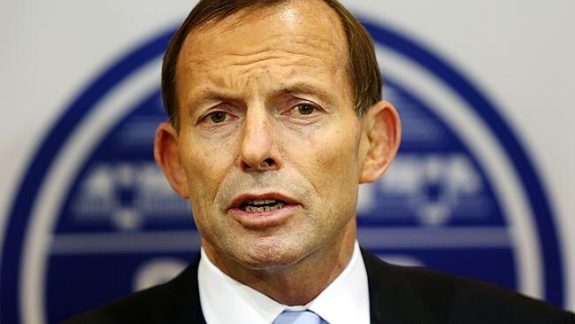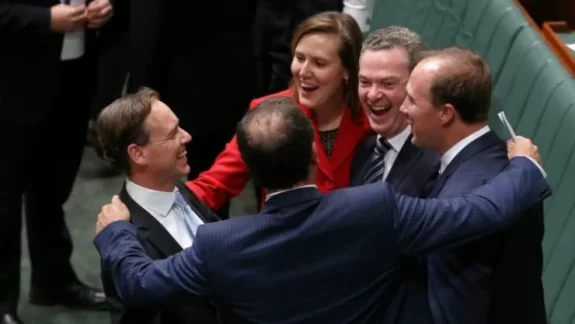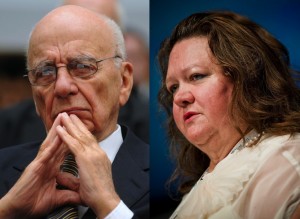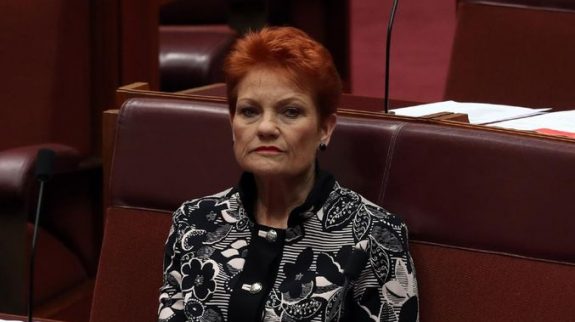Jobs and growth…but for who?
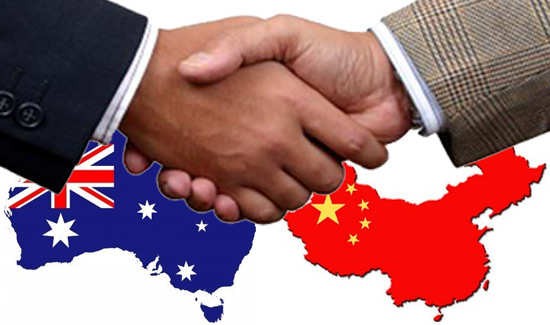
The Abbott government says they are all about jobs and growth, but for who?
In 2012, unions were outraged by a decision to allow Gina Rinehart to import more than 1,700 foreign workers on 457 visas for her latest project in Western Australia.
Paul Howes said “This is a big win for Gina Rinehart, it’s a big win for Clive Palmer, it’s a big win for Twiggy Forrest and it’s a massive kick in the guts, a massive kick in the guts to those 130,000 workers in the manufacturing industry who have lost their jobs since 2008.”
A number of companies in construction, mining and IT hired many more foreign workers than they had applied for. The straw that broke the camel’s back was one company allegedly bringing in 800 workers under the 457 visa in an 18 month period when they were only granted approval for 100 visas over three years.
In 2013, the Labor government tightened the regulations to prevent employers from hiring more workers then they originally advertised to the market.
Tony Abbott’s government have made adjustments to the 457 Visa regulation, allowing employers to again hire an unlimited amount of foreign workers with a temporary working visa.
In April this year, the Federal Government was asked to investigate claims that 457 work visas are being abused at Gina Rinehart’s $10 billion Roy Hill iron ore project in the Pilbara.
The Construction, Forestry, Mining and Energy Union said there were up to 200 Korean white collar 457 visa workers employed by contractor Samsung C&T on the project doing low-level clerical work for Roy Hill’s main construction contractor.
“The allegation is that they’ve been brought in to do certain types of work and then they are being allocated other types of work in breach of their visa conditions.”
Aside from being asked to do work outside their visa conditions, the CFMEU alleged many of the staff were working more than 84 hours a week and being paid as little as $16 an hour.
In March, Gina Rinehart’s mining group, Hancock Prospecting signed off on a $US7.2 billion debt package for her highly anticipated Roy Hill iron ore project in Western Australia’s Pilbara region.
In return for the US government loan, Hancock Prospecting will purchase American mining and rail equipment from Caterpillar, General Electric and Atlas Copco. The Export-Import Bank says their involvement will “support” 3400 US jobs
Since we own the resources, and we have to give approval to any mining venture, why do we not make it a condition of approval that you must use Australian equipment, Australian steel, and Australian workers?
Threats that projects will not go ahead under these circumstances indicate they were not profitable in the first place and, if we are importing equipment and the profit is all going offshore and the employment to lowly paid foreigners, then all we are left with is the environmental damage, railways linking mines to ports paid for with our royalties, and the demise of manufacturing and tourism.
Under the new Free Trade Agreement, Chinese companies will be able to bring skilled workers to Australia to plug labour shortages on big infrastructure projects.
The deal says Chinese-owned companies will be able to ”negotiate similarly to Australian business, increased labour flexibilities for specific projects”.
The arrangements will apply to projects valued above $150 million under the deal negotiated between the two countries. Projects will involve the employment of foreign workers on 457 work visas.
ACTU president Ged Kearney said the effect on Australian jobs would be “disastrous” if the agreement allowed “Chinese contractors on Australian projects to nominate Chinese workers for visas without having to advertise for jobs locally”.
Maritime Union of Australia Western Australian branch secretary Christy Cain hit out at the visa concession and described the measure as “an absolute disgrace”.
“These (mineral) resources are ours and those of the Australians paying taxes for all their lives that are now seeing workshops closing and car manufacturing dying,” Mr Cain said.
“I don’t blame the Chinese, they are saying you want us to invest in Australia then we will bring our own labour over. But it’s ludicrous. What is happening to our Australian values?”
According to a report by the Australian Farm Institute, the value of Australian agricultural exports to China grew by an average 12 per cent a year in the 14 years to 2012. Not bad, except that Chinese imports of agricultural products increased by an annual 16 per cent during the same period. In terms of share of the Chinese market, that means Australia fell from 11 per cent to 6 per cent.
The AFI report says that Australia’s share of US agricultural imports has fallen since the FTA between the two countries came into force in 2005, despite reductions in tariffs. The two countries that achieved the fastest growth in agricultural exports to China over the 14 years to 2012 were the US and Brazil and neither has a free trade agreement with China.
Two Chinese investment groups have established a $3 billion fund to invest in Australian agriculture, as Australia edges closer to securing a free trade deal with China.
The fund, known as the Beijing Australia Agricultural Resource Cooperative Development Fund, is a joint partnership between state-owned Beijing Agricultural Investment Fund and the Shenzen-based Yuhu group.
It will focus on supplying produce back to China, especially infant milk formula, beef, lamb and seafood.
John Lee, a China expert at Sydney University, points out that Chinese policy is to be a net exporter of meat products, rice and wheat by 2025.
That explains why the FTA with Australia contains no concessions for rice and wheat and perhaps also why there is an important, though largely overlooked, qualification to the reduction in tariffs on beef imports. As our Department of Foreign Affairs and Trade puts it, “China has retained the right to apply a discretionary safeguard on beef … if imports exceed a set annual ‘safeguard’ trigger volume.”
The safeguard trigger starts at 170,000 tonnes a year, which is only 10 per cent above Australian exports of 153,000 tonnes of beef to China last year, although there is a so far unspecified provision for the trigger to grow. For exports above this level, the tariff will be reapplied. The department adds, not so reassuringly, that there is a process to “consider” removal of the safeguard.
So it appears the FTA with China has resulted in Chinese investors buying our mines and farms, employing Chinese workers, and then sending the produce back to China at reduced rates. This produce could well fill the 10% trigger for beef leaving Australian farmers’ produce still attracting tariffs.
And when it comes to our huge spending on defence materiel it’s a similar story.
DMO spends up to $10 billion-a-year of taxpayer funds managing more than 200 defence projects ranging from warships to bullets. About 40 per cent of the outlays are absorbed by administration costs.
Australia is considering buying 10 state-of-the-art Soryu class submarines from Japan, at a reported price of more than $20 billion.
Former senior Japanese military personnel, Mr Yamauchi and Mr Ogawa, both told the ABC that an Australian budget of $20 billion would mean that all the construction would have to happen in Japan.
And they said any attempts to do any of the work in Adelaide would double the price.
Mr Ogawa said if construction happened in Japan it would be bad for Australian jobs, but good for the Japanese economy.
“If the issue of military secrets can be resolved then Japanese business will be happy it will bring jobs and growth,” he said.
And then there is the $24 billion that Australia had allocated to buy and deploy a fleet of 72 F-35 Joint Strike Fighter jets.
Critics, including Federal Liberal MP and former analyst with the Defence Science and Technology Organisation, Dr Dennis Jenson, claim that politicians have been manipulated by an elaborate and at times misleading sales pitch by the world’s largest military corporation, Lockheed Martin.
In April Tony Abbott said “Australian business has already won some $1.5 billion worth of work associated with this aircraft. Up to $7.5 billion worth of additional work is there potentially.”
The reality is Australian industries are only contracted for around $370 million work, with Lockheed Martin assurances but no guarantees of more to come. Current contracts are only for 12 months.
Dr Jenson said “The warning I’d give is: don’t bank on the work that you’re being told you’re going to get. You will get it while Lockheed Martin is still pushing very hard for signatures on the dotted line, but once all those signatures are there, don’t bet on winning any future contracts.”
Dr Jenson raised questions about problems posed by the F-35’s heavy weight and the threat that it will be no match for possible adversaries with a high-ranking Lockheed Martin delegation before a joint parliamentary inquiry in Canberra. Lockheed Martin’s response: “We cannot answer that question, just as we cannot answer the threat question, because we get into classified areas very, very quickly.”
RAAF head flight test engineer, Peter Goon, warned “The aircraft is not coming within a bull’s roar of its – some of its operational specifications. The designs are riddled with single points of failure. And many of the critical elements of design have been painted into what we engineers call “coffin corner”.”
“Coffin corner” is the concern that the F-35 couldn’t compete against these cheaper, lighter and more agile Russian and Chinese stealth fighter jets, which are expected to be sold widely around the world.
The US Air Force Combat Command, meantime, has expressed its own reservations. It has warned the US must continue to maintain its older, more agile and far more effective fleet of F-22 jet fighters to back up the F-35s or they’ll be rendered irrelevant. So should Australia instead try to buy the proven F-22? Well, according to the Defence Minister, Australia did ask, but the Americans insisted there was no choice, but to take the troubled F-35 or nothing.
DAVID JOHNSTON: “They’ve said, “No, you can’t have the F-22; that is for the United States Air Force. But you can certainly participate in our program with the Joint Strike Fighter.” We do not have anywhere else to go.”
Is it just me….or are we being screwed here?









